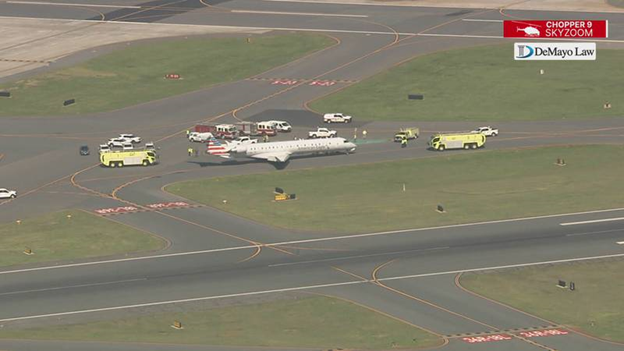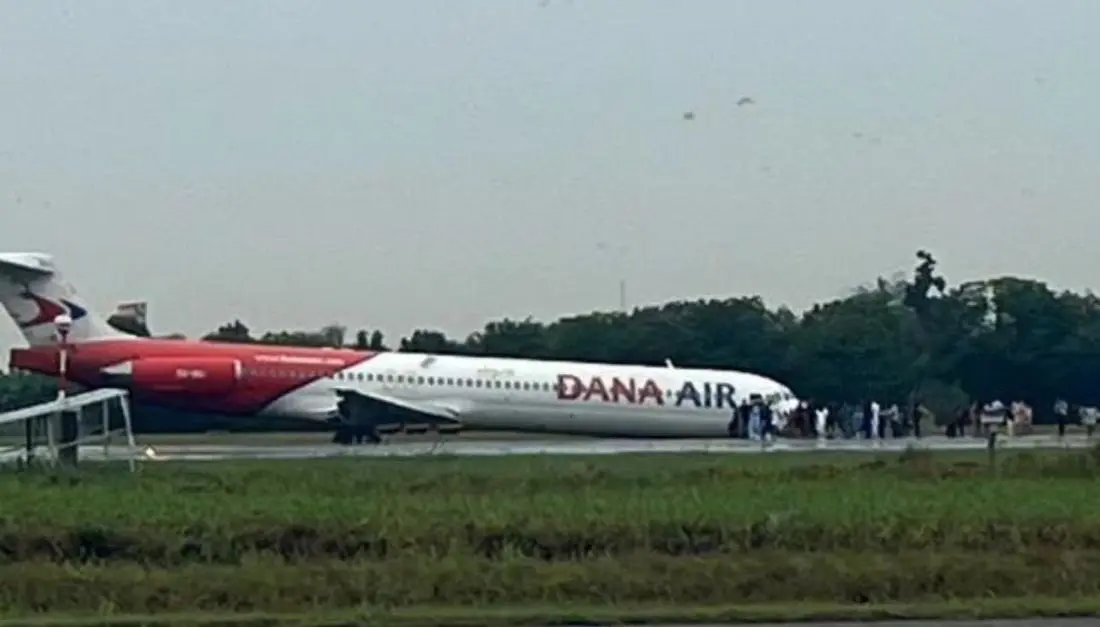ARFF Daily News
Published on:
Tuesday the 23rd of April, 2024
Plane returns safely to Charlotte airport after ‘maintenance issue’
By WSOCTV.com News Staff
CHARLOTTE — A plane landed safely Monday at Charlotte Douglas International Airport after a “maintenance issue,” a spokesperson said.
It happened just before 10 a.m. and involved an American Airlines flight. According to a spokesperson for American Airlines, the plane was headed from Charlotte to Chattanooga but quickly returned after takeoff. The crew reported a possible smell in the cabin.
According to the airport, passengers were bussed back to the terminal. First responders were called to investigate per standard protocol, but paramedics said they did not treat any patients.
The plane was taken out of service and will be inspected by an American Airlines maintenance team, the airline said.
Passengers will board a replacement aircraft to reach their destination, the spokesperson said.
The full statement from American Airlines is below:
“American Eagle flight 5304, operated by PSA Airlines, with service from Charlotte (CLT) to Chattanooga (CHA) returned to CLT shortly after takeoff due to a maintenance issue,” the spokesperson said. “The flight landed safely and the aircraft was taken out of service to be inspected by our maintenance team. Customers will re-depart CLT on a replacement aircraft shortly. We never want to disrupt our customers’ travel plans and apologize for the inconvenience.”


2 Malaysian military helicopters collide and crash while training, killing all 10 crew
Two Malaysian military helicopters collided midair and crashed during a training session on Tuesday, killing all 10 people on board and injuring a swimmer in a pool, authorities said.
By EILEEN NG Associated Press
KUALA LUMPUR, Malaysia — Two Malaysian military helicopters collided midair and crashed during a training session on Tuesday, killing all 10 people on board and injuring a swimmer in a pool, authorities said.
The helicopters were rehearsing at a naval base in northern Perak state for the navy's 90th anniversary celebration when the accident occurred, the navy said in a brief statement. ''All victims were confirmed dead on site,'' it said.
A video circulating on social media purported to be of the incident shows several helicopters flying low in a formation. One of the helicopters veers sideways and clips the rotor of another helicopter, causing both to plunge and crash. A local police officer, who declined to be named because he isn't authorized to speak to the media, confirmed the footage is genuine.
The two choppers were mangled beyond recognition. Rescue workers sifted through the debris to find the bodies. The victims included three women and seven men aged between 26 and 41, authorities said.
Prime Minister Anwar Ibrahim said the nation mourned over the ''heart and soul-wrenching tragedy.'' He said the navy will immediately carry out an investigation to find the cause of the incident.
Seven of the dead crew members were aboard an AW139 maritime operations helicopter, the navy said. That aircraft is produced by AgustaWestland, a subsidiary of the Italian defense contractor Leonardo. The other three were on a Fennec lightweight helicopter, manufactured by European multinational defense conglomerate Airbus.
Defense Minister Mohamed Khaled Nordin said that the anniversary celebration this Saturday will be cancelled and replaced with Friday prayers for the victims.
Khaled said the two helicopters were among seven rehearsing when the collision occurred. One crashed into an empty sports field, while another plunged into a nearby swimming pool. A swimmer sustained injuries after he was hit by debris from the plane, he added.
https://www.startribune.com/2-malaysian-military-helicopters-collide-and-crash-during-training-killing-all-10-people-on-board/600360910/

Plane crashes at North Airport in Nuevo León; no injuries reported
The plane crashed in the cyclonic mesh inside the airport near the highway to Salinas Victoria
Marco Hernandez Cazares
A small plane got lost at the North International Airport in Apodaca, Nuevo León. Civil Protection elements of the entity were mobilized to attend to the accident.
According to a publication by Nuevo León Civil Protection in its official X account, the National Guard and elements of the airport confirmed that the aircraft crashed near the facilities, so no injuries were reported.
In the images shared by the agency, it is observed that the plane crashed in the cyclone mesh inside the airport. Civil Protection detailed that the aircraft is originally from Toluca.
It was circulated in the media that the aircraft had to make a forced landing, which caused the accident.


Dana Air plane crash-lands in Lagos
An aircraft belonging to Dana Air has crash-landed at the Murtala Muhammed International Airport in Lagos.
DAILY POST gathered that the incident occurred on Tuesday morning.
No casualty was recorded, while the details surrounding the incident were not readily available at press time.
https://dailypost.ng/2024/04/23/dana-air-plane-crash-lands-in-lagos/

NTSB Final Report: Extra Flugzeugbau GMBH EA300/L
Contributing To The Accident Was The Pilot’s Use Of Methamphetamine...
Location: Boulder City, Nevada Accident Number: WPR22FA240
Date & Time: July 3, 2022, 08:49 Local Registration: N343BH
Aircraft: Extra Flugzeugbau GMBH EA300/L Aircraft Damage: Destroyed
Defining Event: Aerodynamic stall/spin Injuries: 1 Fatal
Flight Conducted Under: Part 91: General aviation - Personal
Analysis: The pilot departed on a local flight to perform low-altitude maneuvers in a nearby desert valley. The pilot flew into a gap between ridgelines and performed maneuvers that consisted of flying low through the valley and then performing a turn and climb maneuver to fly in the opposite direction. The maneuvers were similar to aerobatic maneuvers called a wingover, in which the airplane makes a steep climb followed by a turn at the top of the climb using the rudder and a descent flying back in the opposite direction from which the maneuver began. If the rudder turn is executed right at the initiation of a stall, the maneuver is known as a stall turn or a hammerhead.
Three turn reversals were accomplished. On the first turn maneuver, the climb rate was nearly 15,000 fpm and the descent rate more than 10,000 fpm. Additionally, the load factor peaked about 3 g. The second turn maneuver was similar to the first but slightly less aggressive. On the third and final turn maneuver, when the accident occurred, the climb rate was about 6,500 fpm and the descent rate was about 6,800 fpm. The roll angles exceeded 90° at the peaks of the maneuvers. The airplane’s airspeed was close to the stall speed at the peak altitude of the first and last turn maneuvers.
According to a witness, the pilot planned to perform the flight maneuvers that morning while a ground photo shoot was taking place. On the final flyby, two witnesses observed the airplane fly overhead and pull up in a climb and subsequently enter a spin towards the ground. The airplane’s engine sounded normal during the flyby maneuvers.
A video taken by a witness showed the airplane performing the low altitude flybys near or below the ridgelines and then enter the vertical turn reversals maneuvers. On the final turn maneuver, the airplane went temporarily out of view, and when back in view, it was in a steep nose-down descent with rotation, consistent with a spin. Impact marks at the accident site, witness observations, review of the flight data, and the video, were all consistent with the pilot losing control by exceeding the critical angle of attack of the airplane during a turn climb maneuver and entering a spin. In addition, examination of the airplane wreckage revealed no evidence of preimpact failures or malfunctions that would have precluded normal operation.
On the last turn maneuver, the pilot experienced a load factor of about 2 g that was the least amount of g sustained during the turn maneuvers performed by the pilot. Referencing the Federal Aviation Administration (FAA) Advisory Circular (AC) 91.61 on g effects; 2 g was substantially below the threshold and minimum range of grey out, which was the first effect of the g-forces that would affect the pilot. Therefore, it was likely that the pilot did not experience any adverse effects (greyout, blackout, or incapacitation) from the g load during the final turn maneuver.
The FAA Code of Federal Regulations (CFR) Title 14. 91.303 Aerobatic flight, states “No person may operate an aircraft in aerobatic flight - below an altitude of 1,500 ft above the surface.” The pilot was not in compliance with this requirement, which reduced his recovery margin. Toxicology testing revealed that the pilot had used methamphetamine at some time before the accident. Methamphetamine and its metabolite amphetamine were detected at high concentration in the urine sample, and it was likely that the pilot was still under the influence and experiencing some effects of methamphetamine while flying. Pseudoephedrine and phenylpropanolamine, which are precursors for illicit production of methamphetamine, were detected in the urine. This further supports the evidence of recreational and illicit use of methamphetamine by the pilot. Methamphetamine effects include impaired judgment, impulsivity, and increased risk taking. Therefore, the effects from the pilot’s use of methamphetamine likely contributed to the accident.
Probable Cause and Findings: The National Transportation Safety Board determines the probable cause(s) of this accident to be -- The failure of the pilot to maintain control of the airplane by exceeding the airplane’s critical angle of attack while maneuvering in a turning climb at a low altitude, which resulted in an
aerodynamic stall and spin from which the pilot was unable to recover. Contributing to the accident was the pilot’s use of methamphetamine and decision to perform aerobatics below the required minimum altitude.
FMI: www.ntsb.gov

Today in History
45 Years ago today: On 23 April 1979 a SAETA Vickers Viscount went missing on a Quito-Cuenca flight; killing all 57 occupants.
Date: Monday 23 April 1979
Time: 07:45
Type: Vickers 785D Viscount
Owner/operator: SAETA
Registration: HC-AVP
MSN: 329
Year of manufacture: 1957
Engine model: Rolls-Royce Dart 510
Fatalities: Fatalities: 57 / Occupants: 57
Aircraft damage: Destroyed, written off
Category: Accident
Location: Pastaza Province - Ecuador
Phase: En route
Nature: Passenger - Scheduled
Departure airport: Quito-Mariscal Sucre Airport (UIO/SEQU)
Destination airport: Cuenca Airport (CUE/SECU)
Narrative:
Went missing on a Quito-Cuenca flight and was found 5 years later on high ground, 25nm off track at an elevation of 18000 feet.
The aircraft departed Quito at 07:08 in the morning and was expected to land at Cuenca at 08:00.

Mailing Address
Subscribe to our newsletter
Contact Us
We will get back to you as soon as possible.
Please try again later.
